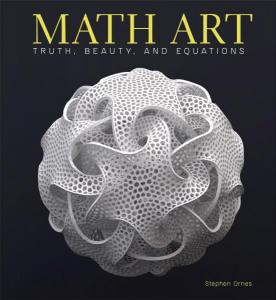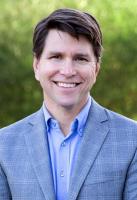
Stephen Ornes: Math Art
For this column, NASW book editor Lynne Lamberg asks NASW authors to tell how they came up with the idea for their book, developed a proposal, found an agent and publisher, funded and conducted research, and put the book together. She also asks what they wish they had known before they began working on their book, what they might do differently the next time, and what tips they can offer aspiring authors. She then edits the A part of that Q&A to produce the author reports you see here.
Publication of NASW members’ reports in Advance Copy does not constitute NASW’s endorsement of their books. NASW welcomes your comments and hopes this column stimulates productive discussions.
MATH ART:
TRUTH, BEAUTY, AND EQUATIONS
Stephen Ornes
Sterling, April 16, 2019, $24.95
ISBN 10: 1454930446; ISBN 13: 978-1454930440
Ornes reports:
I wanted to write a book about art inspired by math because it’s a broad and growing topic I’ve been reporting on for some time. Math is deeply aesthetic, but most people never get to the good stuff.
There’s a growing tribe of people who create art inspired by math. They paint, print, code, sculpt, crochet, and weave. My book highlights 19 artists, and includes short essays to explain why the math is interesting.
I don’t have an agent. Two years ago, an editor at Sterling called me after she’d seen some of my articles on a different topic and asked if I thought they added up to a book. I said no. She asked what else I was doing, and I told her about mathematical artists. She got excited, I got excited, and I sent a book proposal. I have written proposals in the past for other unwritten books, but I’ve never had one accepted.My editor offered feedback. I revised the proposal, and it got the green light. I negotiated for the publisher to pay for licensing fees and for a mathematician fact-checker to comb through the manuscript. Since my advance did not allow me to devote myself exclusively to the book between signing and deadline, I continued to take on magazine assignments while working on the book.
I identified artists by searching online galleries of art exhibits, combing through art and math journals, and asking artists I already knew for recommendations.
With the leftover material, I have created a podcast called Calculated, and I released the first two episodes in time for Pi Day this year.
If I had it to do over again, I would have included more artists and pushed harder for an advance that would have paid for travel. My advice to aspiring book writers is to invest time at the beginning to think about the reading audience, develop a clear sense of the book’s purpose, and map out the structure, even if you end up abandoning it. These foundations let me see, as I went along, what to include and what to save for Volume 2.
Contact info:
- Stephen Ornes, 857-753 5252, Stephen.ornes@gmail.com, https://stephenornes.com/, @stephenornes
- Book: https://truthbeautyequations.com/
- Podcast: http://calculated.truthbeautyequations.com/
NASW members: will your book be published soon? Take advantage of this opportunity for shameless self-promotion. Submit your report for Advance Copy.
Tell your fellow NASW members how you came up with the idea for your book, developed a proposal, found an agent and publisher, funded and conducted research, and put the book together. Include what you wish you had known before you began working on your book, or had done differently.
See https://www.nasw.org/advance-copy-submission-guidelines.
View Advance Copy archives at https://www.nasw.org/member-article/advance-copy.
Thinking of writing a book? If you are a NASW member, you may access a list of more than 150 books and online resources to help you craft your book proposal, find an agent and funding sources, negotiate your contract, learn about self-publishing, publicize and market your book, and more at https://www.nasw.org/article/write-book.
Send book info and questions about book publishing to Lynne Lamberg, NASW book editor, llamberg@nasw.org.
Image: State Library Victoria in Melbourne by Benjamin Ashton on Unsplash.
Advance Copy
The path from idea to book may take myriad routes. The Advance Copy column, started in 2000 by NASW volunteer book editor Lynne Lamberg, features NASW authors telling the stories behind their books. Authors are asked to report how they got their idea, honed it into a proposal, found an agent and a publisher, funded and conducted their research, and organized their writing process. They also are asked to share what they wish they’d known when they started or would do differently next time, and what advice they can offer aspiring authors. Lamberg edits the authors’ answers to produce the Advance Copy reports.
NASW members: Will your book be published soon? Visit www.nasw.org/advance-copy-submission-guidelines for information on submitting your report.
Publication of NASW author reports in Advance Copy does not constitute NASW's endorsement of any publication or the ideas, values, or material contained within or espoused by authors or their books. We hope this column stimulates productive discussions on important topics now and in the future as both science and societies progress. We welcome your discussion in the comments section below.


